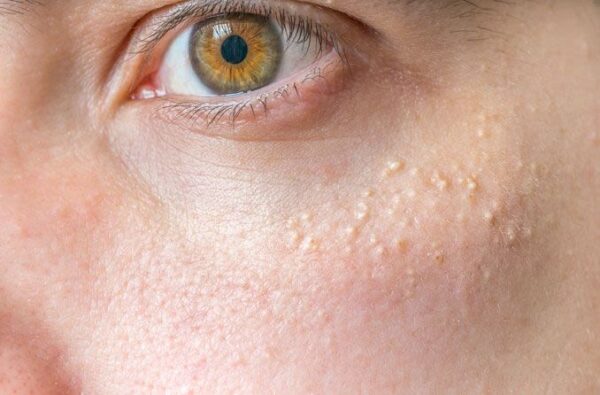Greetings to our beloved readers! Today, we embark on a journey into the realm of Milialar, those tiny white spots that occasionally grace our skin. Whether you’ve recently discovered them or not, understanding what Milialar is and how to treat it is crucial for maintaining clear and radiant skin. Let’s dive into the world of Milialar causes, symptoms, home remedies, and professional treatments, ensuring our skin remains healthy and blemish-free!
Unveiling the Mystery of Milialar : Causes Explored
Ever heard of Milialar? They’re those little white spots often called milk spots or oil seeds that show up around your eyes, nose, cheeks, and forehead. Now, we’re not entirely sure what causes them, but things like dead skin cells, sebum in hair follicles, sweat glands, skin damage, or even using specific skincare products might play a role in making them pop up. It’s like a mystery game for your skin.
Understanding the root causes of Milialar not only helps in prevention but also aids in selecting suitable skincare products. Let’s delve deeper into the various types of Milialar.
Exploring the Milialar Landscape: Different Types Unveiled
Milialar manifests in diverse forms, each requiring a tailored approach to skincare:
Primary Milialar:
The most common type found in both infants and adults, originating from trapped dead skin cells beneath the skin’s surface. Typically, these tiny cysts resolve within weeks or months.
Secondary Milialar:
Resulting from burns, blistering conditions, or prolonged sun damage, this type may also emerge due to cosmetic procedures like laser treatments.
Neonatal Milialar:
Seen on newborns’ noses and cheeks, neonatal Milialar is caused by undeveloped sweat ducts and usually disappears without intervention within a few weeks.
Several Eruptive Milialar:
Characterized by a sudden eruption of multiple small lumps on the face, arms, and trunk, this type may be genetic or linked to porphyria cutanea tarda.
Understanding the nuances of Milia types aids in better managing and addressing your unique situation.
Decoding Milialar Symptoms: Recognizing the Telltale Signs
Milia, or milk spots, appear as small white or yellowish pimples on the face and body. Although benign, they can be bothersome. Recognizing common Milialar symptoms involves noting the presence of tiny, smooth white or yellowish bumps that may resemble pimples or cysts.
Unlike acne, Milialar rarely cause redness or irritation, and they typically do not itch or hurt. Resist the temptation to squeeze or pick at them, as this may lead to mild irritation. Persistent Milialar may warrant a visit to a dermatologist for personalized treatment.
Home Sweet Home: Natural Remedies for Milialar
Curious about natural remedies for Milialar? Home-based solutions may include:
Gentle Exfoliation:
Scrubbing affected areas with a mild exfoliating cleanser or soft washcloth helps remove dead skin cells, clearing pores and promoting Milialar dissolution.
Topical Treatments:
Consider using retinol or alpha-hydroxy acid topical creams or serums to increase cell turnover and dissolve Milialar-causing keratin.
Kitchen Wonders:
Applying honey or tea tree oil, known for their antimicrobial properties, may reduce inflammation and infection.
While these remedies may work for some, individual skin variations mean that what works for one person may not work for another. If in doubt, consult a skincare specialist for personalized advice.
Seeking Professional Help: Treating Severe Milialar Cases
For persistent or severe Milialar cases, professional intervention may be necessary. Dermatologists and skincare specialists offer advanced treatments such as:
Extraction:
Gentle removal of cysts using a sterilized needle or scalpel, performed by a skilled specialist to avoid scarring or infection.
Chemical Peels:
Application of a chemical solution to peel off the outer skin layer, clearing pores and removing Milialar-causing dead skin.
Laser Ablation:
Targeted laser light destroys cysts without harming surrounding tissue, providing a fast and painless solution for extensive Milialar outbreaks.
In severe cases, multiple sessions of professional treatment may be required, so it’s crucial to follow aftercare recommendations for optimal recovery and prevention of complications.
Preventing Milia: Tips for Radiant, Blemish-Free Skin
Preventing Milia involves adopting a diligent skincare routine. Here are some tips for maintaining clear, Milialar-free skin:
Gentle Cleansing:
Use a mild cleanser twice a day to remove dirt, oil, and makeup, avoiding abrasive scrubs.
Smart Exfoliation:
Incorporate gentle exfoliation with smooth granules, AHAs, or BHAs to eliminate dead skin cells.
Lightweight Moisturizing:
Opt for non-comedogenic, lightweight moisturizers to avoid congested pores and minimize skin dryness.
Sun Protection:
Use broad-spectrum sunscreen with at least SPF 30 daily to protect against sun damage, a potential trigger for Milialar.
Mindful Product Choices:
Select oil-free or non-acnegenic makeup and remove it before bedtime to prevent residue buildup.
Avoid Certain Drugs:
Steer clear of topicals with steroids or potent retinoids that may increase the risk of Milialar.
Consistent adherence to these skincare practices will contribute to smooth, Milialar-free skin. Remember, individual skin needs vary, so consulting a dermatologist ensures personalized advice tailored to your unique condition.
Wrapping Up: Embracing Milia Awareness for Healthy Skin
In conclusion, effective Milia treatment and prevention hinge on informed skincare practices. Familiarize yourself with the causes, symptoms, and types of Milialar, and tailor your skincare routine accordingly.
Regular cleansing, gentle exfoliation, and nourishing your skin with essential vitamins contribute to a healthy complexion. While home remedies may suffice for minor Milialar, professional treatments are available for persistent or severe cases.
Wash, moisturize, and protect your skin from the sun to keep Milia at bay. Every skin is unique, and consulting a dermatologist ensures that you receive the best guidance for managing Milialar and maintaining your skin’s overall health. Here’s to radiant, blemish-free skin on our shared skincare journey!
